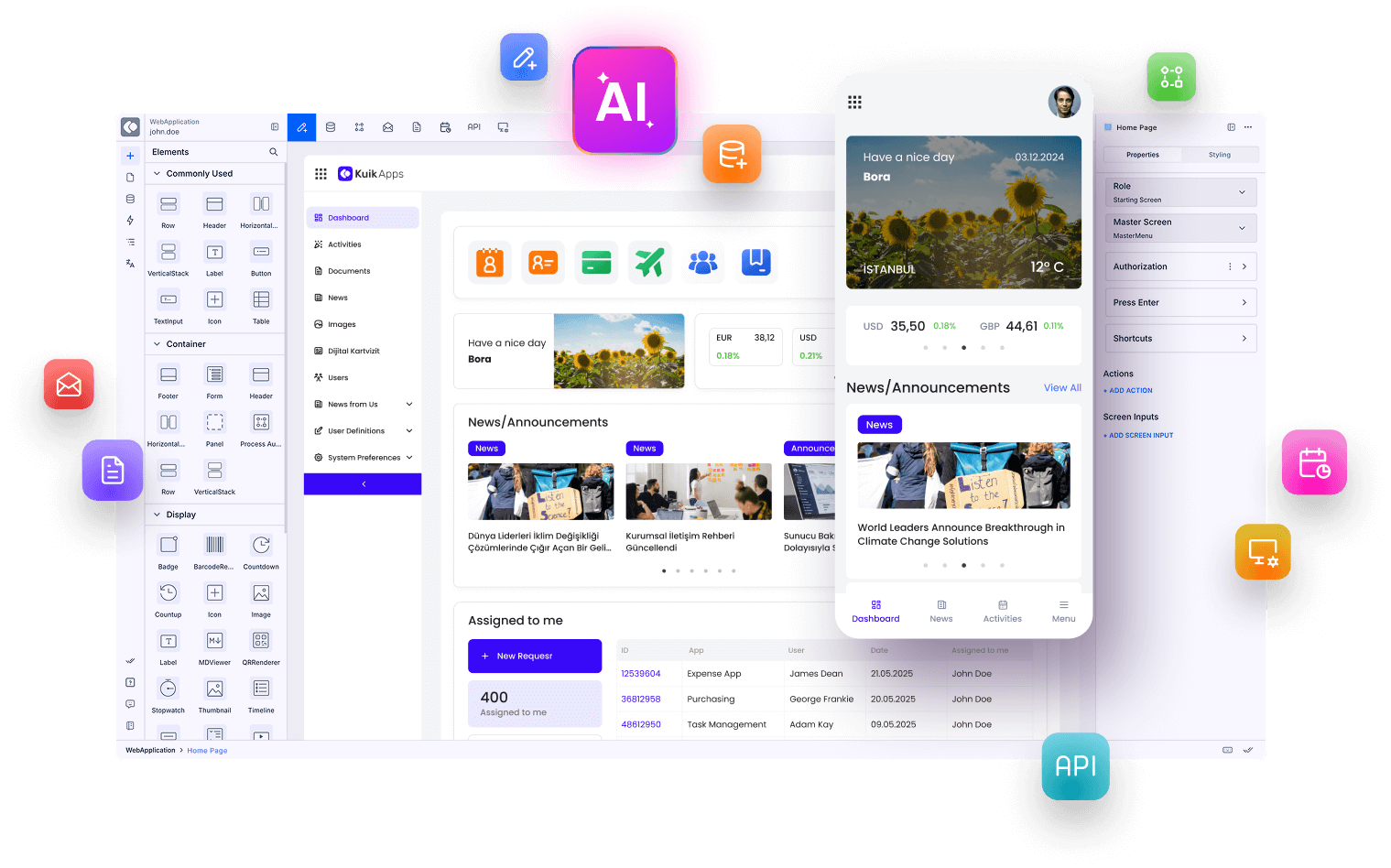The need for speed in today's world not only caused the software industry to adopt agile methodology in development processes, but also fueled innovative approaches like low-code and no-code app development, which emerged as viable and quicker alternatives to traditional coding.
Low-code/no-code platforms empower anyone, tech-savvy or not, to build apps with less or no coding required. Even though these approaches are gaining recognition day by day, many still don’t know what low-code and no-code app development is. In this article, we'll dive deeper into the use of low-code and no-code platforms and break down the differences between the two.
What is low-code and no-code development?
Low-code and no-code development platforms are visual software development tools that minimize or reduce the need for coding. The main difference between low-code and no-code development is that low-code platforms require minimal knowledge of coding while no-code is based solely on visual-based models and eliminates the need for complex coding languages.
Low-code platforms offer pre-built components and visual tools along with the option to write custom code for finer control. They stand out by providing more flexibility and control to users when compared to no-code platforms. So, they allow for the development of more complex applications and integrations. They are mostly preferred by business users with some technical skills, citizen developers, and IT professionals who are aiming to speed up the development process.
No-code platforms do not require any hand coding to create apps. Instead, they use visual-based models, such as drag-and-drop builders and pre-built components, to enable you to develop application software through a graphical user interface (GUI). Their reliance on visual interfaces makes them suitable for anyone regardless of their technical skills. Since no-code platforms offer less flexibility and customization compared to traditional coding, they are the go-to solution for developing simple apps, prototypes, and internal workflows.

The benefits of low-code and no-code over traditional coding methods
Low-code/no-code offers numerous benefits to businesses and individual enterprises. Let’s take a deeper look at the advantages of using low-code and no-code platforms over traditional coding methods.
Faster development
Low-code and no-code platforms allow their users to develop and deploy applications faster as they minimize or eliminate the need for manual hand coding. In this way, the project timelines can be reduced from months to days and this can result in quicker time-to-market.
Increased efficiency
Thanks to the visual tools they offer, both low-code and no-code solutions increase development efficiency by allowing for quicker creation of prototypes and iteration on your designs.
Improved collaboration
Low-code/no-code platforms can improve collaboration between business and IT teams. These platforms provide a visual representation of application development, which can help bridge the gap between technical and non-technical teams. This can improve communication and collaboration, leading to more successful and innovative projects.
Reduced costs
Low-code and no-code methods are more cost-effective than manual development from scratch because they significantly reduce the costs related to software development. These platforms require less coding expertise and infrastructure, so they eliminate the need for expensive development resources, such as specialized developers and hardware. Such significant cost savings can be significant especially for small to medium-sized enterprises, as well as large-scale businesses.
Low-code/no-code is what a business needs in the digital age
In the rapidly developing and competitive software industry, agility is the key to staying in the competition. If you too think that spending months on app development is not practical, then low-code solutions may be the way forward for you.
Low-code platforms employ visual tools and pre-built components to streamline the application development process. This makes low-code/no-code platforms an ideal option for businesses looking to enhance their applications or build new ones while minimizing costs and maximizing efficiency.
Through low-code platforms, businesses can easily control the development process, and improve their bottom line, resulting in faster time-to-market. Plus, low-code development platforms are becoming increasingly more powerful and versatile, so you can create practically any type of application you need.

Are low-code/no-code solutions useful for you?
The answer to the question of whether low-code or no-code solutions are good options for you depends on your needs and preferences. Here we prepared a list of some key considerations for you to keep in mind when deciding if you should use low-code development platforms:
- The specific needs and requirements of your project: If you need a quick and easy way to create an application without diving into the intricacies of manual coding, then a low-code or no-code platform could be a good option for you. Low-code development appears as a more suitable option for those aiming to develop apps with more complex structures. No-code platforms, on the other hand, cater to non-technical users who cannot write code manually.
- Your budget: It’s for sure that both low-code and no-code solutions appear as budget-friendly platforms that help you save money by eliminating the need to hire a developer or learn traditional coding languages.
- Your timeline: Low-code platforms allow you to launch your application within days, while traditional coding methods can take months or even years.
- Your level of experience: No-code platforms cater to anyone regardless of their experience in coding to create functional apps with simple drag-and-drop interfaces and pre-built components. But if you possess some coding savvy, low-code solutions unlock even greater potential.
So, which is more suitable for you – low-code or no-code?
There is not a one-size-fits-all answer to this question. Both have their pros and cons, so these differences between the low-code and no-code methods, and your specific needs and preferences play a significant role in determining which is more suitable for you. Let’s take a closer look at this general guideline that can help you decide which approach is best for your project:
- Low-code development tools can be beneficial if you're short on time or if you're not an experienced coder.
- With no-code development tools, on the other hand, you can develop an application without any coding knowledge.
- Low-code tools can be more expensive than no-code tools, and they may not offer as much flexibility when it comes to customizing your application.
- No-code development tools can be less expensive than low-code tools, but they require more time to learn how to use them effectively.
How can you get started with low-code/no-code development?
If you are new to the innovative approaches of low-code development and need more direct and practical guidance, explore Kuika Academy. It’s developed to help users make the most of our platform by learning the ins and outs of low-code/no-code development within Kuika’s structured and user-friendly environment.
What sets Kuika apart from the other platforms is that it not only offers a drag-and-drop interface for rapid development, but also hands over the source code to you, so that you have complete ownership and control over your projects.
Whether you’re a software developer looking for efficient ways to create apps, a citizen developer aiming to build an app without extensive coding knowledge, or an enterprise aiming to streamline your development process, Kuika Academy provides the foundational knowledge you need. Dive into the world of low-code with Kuika and unlock a realm of possibilities where your ideas can come to life faster and more efficiently than ever before.
















